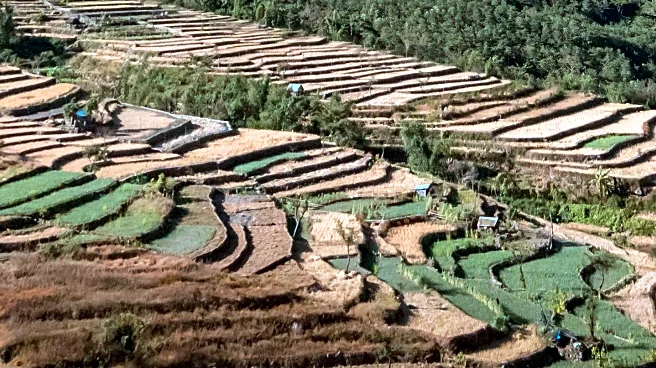What's Happening?
Archaeologists have conducted a detailed analysis of starch residues found on lithic artifacts from the Fenghuangzui Neolithic site in Central China. The site, located in Xiangyang City, Hubei Province, dates back to the Shijiahe Culture period, approximately 4400 to 4200 years ago. Excavations revealed two strata within feature H13, containing various artifacts including pottery, lithics, and animal bones. The study focused on 23 lithic specimens, primarily chipped lithic artifacts, to understand their function and the subsistence practices of the period. Starch granule analysis was performed to identify plant residues, providing insights into the diet and agricultural practices of the Shijiahe Culture, which relied heavily on rice farming, supplemented by fishing, hunting, and gathering.
Why It's Important?
This research is significant as it enhances understanding of Neolithic subsistence strategies and tool usage in the middle Yangtze River valley. The findings contribute to knowledge about early agricultural practices, particularly rice cultivation, which played a crucial role in the diet of the Jianghan Plain's inhabitants. By analyzing starch residues, archaeologists can infer the types of plants processed and consumed, offering a glimpse into the daily life and technological advancements of ancient societies. This study also highlights the importance of archaeobotanical research in reconstructing historical diets and economies, providing a scientific basis for understanding human adaptation and cultural development during the Neolithic period.
What's Next?
Future research may expand on these findings by applying starch granule analysis to other Neolithic sites in the region, potentially uncovering broader patterns of plant use and agricultural development. Continued excavation and analysis could further illuminate the technological and cultural evolution of the Shijiahe Culture. Additionally, interdisciplinary studies combining archaeobotany, anthropology, and environmental science could offer deeper insights into the interactions between ancient human populations and their environments, informing modern agricultural and ecological practices.
Beyond the Headlines
The study of starch residues on lithic artifacts not only sheds light on ancient diets but also raises questions about the evolution of food processing technologies and their impact on societal development. Understanding the role of agriculture in shaping social structures and economies during the Neolithic period can provide valuable lessons for contemporary food security and sustainable farming practices. Moreover, this research underscores the importance of preserving archaeological sites and artifacts, as they hold the key to unraveling the complexities of human history and cultural heritage.












